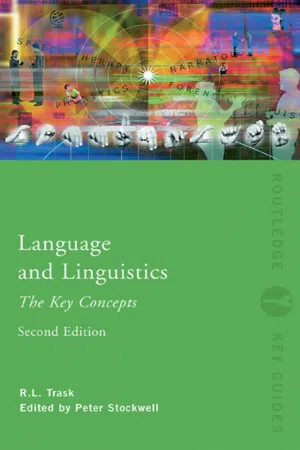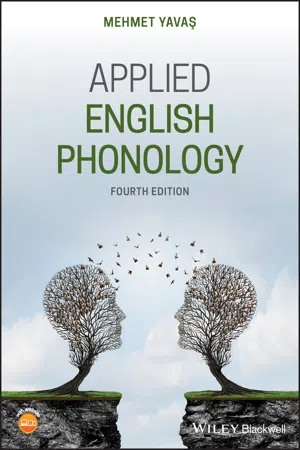Languages & Linguistics
Complementary Distribution
Complementary distribution refers to a linguistic phenomenon where two distinct sounds or forms cannot occur in the same linguistic environment. Instead, they appear in mutually exclusive contexts. This means that one sound or form occurs where the other does not, and vice versa. This concept is important in phonology and morphology for understanding the distribution of linguistic elements within a language.
Written by Perlego with AI-assistance
3 Key excerpts on "Complementary Distribution"
Learn about this page
Index pages curate the most relevant extracts from our library of academic textbooks. They’ve been created using an in-house natural language model (NLM), each adding context and meaning to key research topics.
- eBook - ePub
How to Study Linguistics
A Guide to Understanding Language
- Geoffrey Finch, Martin Coyle, John Peck(Authors)
- 2017(Publication Date)
- Bloomsbury Academic(Publisher)
Complementary Distribution states that if two sounds, or to use the term we introduced in Chapter 3, ‘phones’, never occur in the same environment, that is, the same position in a word, they may be members of the same phoneme. So, for example the two l s which we identified in Chapter 3 – clear l and dark l – are in Complementary Distribution. Clear l, or [l], occurs before vowels – for example, lip, lead – and dark l, or [ ], occurs before consonants and word finally – milk, mill. Many allophones fulfil this criterion of Complementary Distribution but there are some which do not. These are the ones which are covered by the second criterion of free variation. This states that if two or more phones occur in the same environment, but without changing the word in which they occur, they may belong to the same phoneme. A good example of this is the consonant phoneme at the end of bid. Like many other voiced plosives at the end of words it sometimes loses its voicing due to the fact that sounds in these positions are weakly articulated. Sometimes, then, we may pronounce this word with a devoiced /d/ – [ ], and sometimes with the normal voiced variant – [d]. It doesn’t matter which, because however we pronounce it the sounds are not contrastive – the difference does not produce a new word. So [d] and [ ] are in free variation. F IGURE 6.3 F IGURE 6.4 6.2.2 Intonation Another way in which we can extend our study of sound is by considering the relationship between the sound system and the levels of syntax and semantics. To do this involves examining a unit larger than the phoneme: the syllable. Have a look back at what we said about the syllable in Chapters 2 (Section 2.2.1, vii), and 3 (Section 3.2). I suggested there that the best way to view the syllable was as a unit of rhythm, indeed, the smallest we have in the language. All language is rhythmically organised - eBook - ePub
- R.L. Trask, Peter Stockwell(Authors)
- 2007(Publication Date)
- Routledge(Publisher)
DISTRIBUTION
The set of positions in which a given linguistic element or form can appear in a language. The notion of distribution is a central feature of the approach to language study called structuralism, and it was outstandingly important in the version called American structuralism.Distribution is a simple notion. Any given linguistic element which is present in a language, whether a speech sound, a phoneme, a morpheme, a word, or whatever, can occur in certain positions but not in other positions. A statement of its possible positions is its distribution, and this distribution is usually an important fact about its place in the language.For example, distribution is important in identifying parts of speech. In English, any word which can occur in the slot in This – is nice must be a noun, because English allows only nouns to occur in this position. And larger syntactic categories can be partly identified in the same way: anything that can occur in the slot in – is nice must be a noun phrase.But distribution is perhaps most prominent in phonology. Consider the English labiodental fricatives [f] and [v]. Simplifying slightly, in Old English, the sound [v] could only occur between vowels, while [f] could never appear between vowels. Hence Old English allowed words like [fi:f] ‘five’, [fæ:t] ‘fat’, [livian] ‘live’ (verb), and [ov er] ‘over’, but no words like *[væ:t] or *[ofər]. We say that, in Old English, [f] and [v] were in Complementary Distribution, meaning that there was no position in which both could occur. Since the two sounds are phonetically similar, we can therefore assign both to a single phoneme, usually represented as /f/. Indeed, the Old English spellings of the four words were fif, fatt, lifian and ofer, reflecting the fact that only one phoneme existed.In modern English, however, the distribution of these two sounds is very different: they can both occur in the same positions to make different words. We thus have minimal pairs like fat and vat, fine and vine, rifle and rival, and strife and strive. We therefore say that [f] and [v] are in contrastive distribution - eBook - ePub
- Mehmet Yavas(Author)
- 2020(Publication Date)
- Wiley-Blackwell(Publisher)
] and [ð] by speakers of Spanish. These examples show that whether the users of a given language would be attuned to a given phonetic difference simply depends on whether that difference is contrastive (capable of changing the meaning of words) in that language.Whether a given phonetic difference is meaningful (i.e. easily perceived, catches the attention of native speakers, etc.) has to do with the functional (contrastive) status in a language, and this has to do with the distribution of sounds in a given sound system.2.2 Complementary versus Overlapping Distribution
2.2.1 Overlapping distribution and contrast
In languages, sounds are in either of two types of distribution. When two sounds are capable of occurring in the same environment, we say that these sounds are in overlapping distribution. For example, the sounds [l] and [ ] are in overlapping distribution in English, because they can be found in the same environment, as exemplified by the following pairs of words:- lake [lek] – rake [ ek]
- mole [mol] – more [mo ]
- elect [ɪlεkt] – erect [ɪ εkt]
The examples above show that the sounds [l] and [ ] are capable of occurring in the same environment (in word‐initial position, followed by the same sound, in (a); in word‐final position, preceded by the same sounds, in (b); and medially, preceded and followed by the same sounds, in (c)). It should be mentioned that the environments relevant to the distribution can be defined in terms of word or syllable position, neighboring sounds (preceding and/or following), or suprasegmentals.When we have an overlapping distribution as shown above, we say that the sounds in question are in a non‐predictable distribution. An overlapping distribution is not required to manifest itself in multiple positions; one environment will be enough to conclude the overlap. For example, the sounds [n] and [ŋ] in English may be found in an overlapping distribution only in a syllable‐final position (e.g. kin [kɪn] – king


